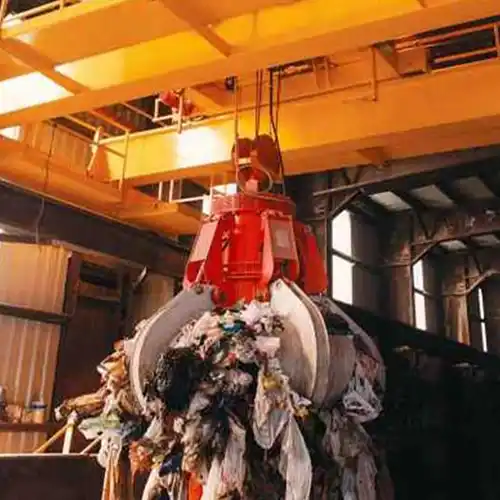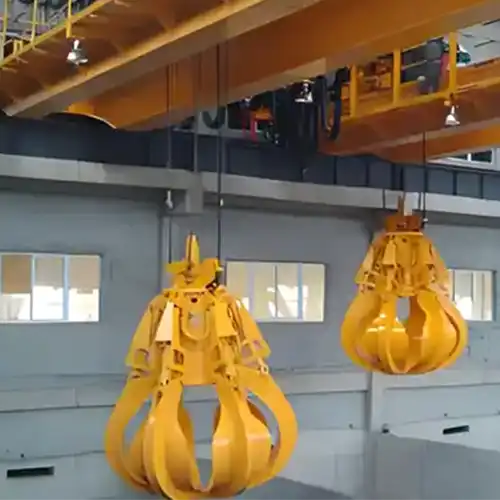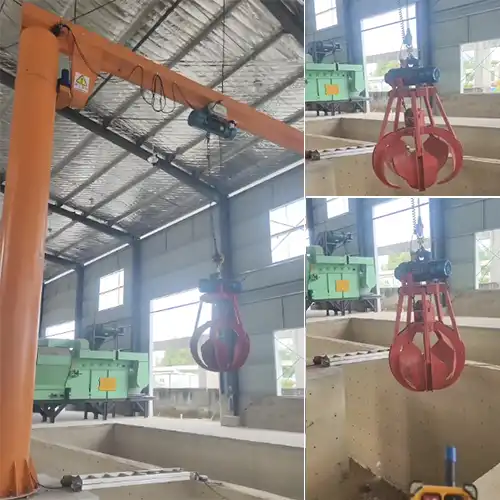Choosing the Right Grab Bucket for Waste Handling Cranes
A practical guide to selecting hydraulic & electro-hydraulic orange peel grabs for efficient & safe waste handling operations. Get grab bucket & cranes.
Category: Featured
Your Trusted Waste Handling Crane Manufacturer & Supplier
Choosing the Right Grab Bucket for Waste Handling Cranes
A Guide to Hydraulic and Electro-Hydraulic Orange Peel Grabs
Introduction: Waste Handing Crane & Grab Bucket
In today's waste management operations, picking the right waste handling crane and grab bucket system is more important than many realize. It affects not just safety, but also how smoothly and efficiently your materials move around the site.
This guide focuses on the most common types of grabs you'll find in the field—especially hydraulic orange peel grabs and electro orange peel grabs. Understanding the differences between these will help you choose the best fit for your specific needs.
Whether your job involves bulky scrap metal, mixed construction debris, or even fine waste, having the right orange peel grab bucket can make a noticeable difference in getting the work done faster and with less hassle.
Waste Handling Cranes
Selecting the right waste handling crane is important for smooth and efficient material movement. Different types of cranes work better in different settings, and pairing them with the correct waste handling grab makes a big difference on site.
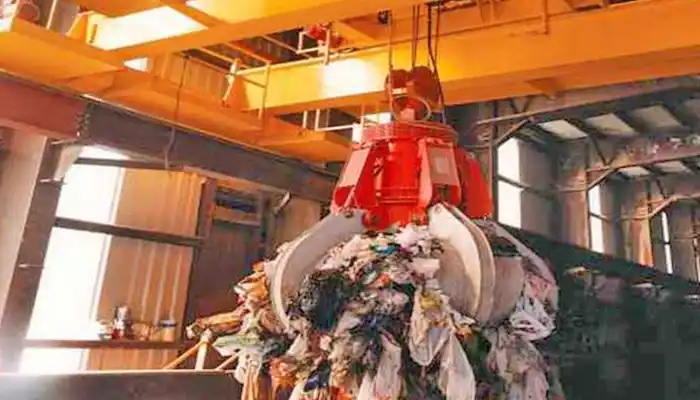
Types of Waste Handling Cranes
- Gantry cranes are heavy-duty machines designed for outdoor use in scrap yards and ports. They cover large areas and can handle bulky loads, often working with strong waste handling grabs like hydraulic orange peel grabs.
- Overhead cranes are commonly used indoors at recycling centers or waste processing plants. They are suitable for lifting lighter loads in tight spaces and typically use smaller, precise waste handling grabs for sorted or finer materials.
- Jib cranes are compact and flexible, ideal for spot lifting or moving waste within a localized area. They pair well with versatile waste handling grabs for quick and efficient handling tasks. Check 5 ton pillar jib crane with grab bucket for waste handling project.
Common Waste Types Handled by Waste Handling Cranes and Grabs
- Ferrous and non-ferrous scrap metals such as steel, copper, and aluminum usually come in irregular shapes and heavy bundles. Handling this kind of material requires waste handling grabs with a strong grip suited for uneven scrap.
- Municipal solid waste includes mixed household and commercial garbage that needs bulk handling. General-purpose waste handling grabs used with versatile cranes are common here.
- Construction and demolition debris like concrete chunks, bricks, and wood pieces are rough and bulky. These materials call for durable waste handling grabs matched with cranes capable of managing heavy loads.
- Organic and recyclable materials such as compost, plastics, and paper require careful handling to avoid damage. The right combination of waste handling crane and grab ensures efficient and safe lifting.
Matching the waste handling crane with the appropriate waste handling grab based on the material type is a key step to improving productivity and reducing downtime in waste management operations. Check more types of grab bucket cranes for your selection.
Power Systems: Electric vs. Hydraulic Grab Buckets
Understanding how grab buckets are powered helps you choose the right setup for your waste handling crane and material.
Electric grab bucket
Electric Grab Buckets
Electric grab buckets run off the crane's electrical system. They are simple and easy to maintain, making them a good fit for lighter applications where speed and low upkeep matter more than heavy lifting power.
- Best suited for handling lighter waste and bulk materials.
- Require no hydraulic connections, simplifying installation.
- Typically lower initial cost and less complex to operate.
Electro Hydraulic Orange Peel Grabs
This type combines an electric motor with a self-contained hydraulic pump, offering the benefits of both systems without needing external hydraulic lines.
- Easy to retrofit onto cranes without built-in hydraulics.
- Commonly used in scrap handling grab operations where power and flexibility are important.
- Requires only electrical power, reducing installation complexity.
Hydraulic Grab Buckets
Hydraulic grab buckets use the crane's hydraulic system or a separate hydraulic power unit. They provide a much stronger gripping force, which is necessary for handling heavy or irregular waste.
- Ideal for scrap yards and construction debris.
- Able to grip tough, bulky materials securely.
- Require hydraulic lines and routine maintenance of hoses and pumps.
Choosing the right power system for your grab bucket depends on your crane's capabilities and the type of waste you handle. Electric grabs work well for lighter loads and simple setups, while hydraulic and electro hydraulic grabs provide the strength needed for heavy-duty waste handling.
Types of Grab Buckets for Waste and Scrap Handling
Picking the right grab bucket really depends on what kind of waste you're dealing with. Different grabs are built for different jobs, so it pays to know what fits your material and crane.Check 12 types of grab buckets for sale.
Hydraulic Orange Peel Grab
This one's got several "fingers" or tines—usually four to six—that close around the load like a claw. It's great for grabbing big, odd-shaped stuff like scrap metal, shredded pieces, and other bulky debris.
- You'll often see this type used in scrap yards or demolition sites.
- It needs hydraulic power, so your crane has to have hydraulic lines or an external system.
- It gives a solid, powerful grip on heavy, irregular materials.
Electro Hydraulic Orange Peel Grab
This grab is kind of like a hydraulic grab with its own built-in pump powered by an electric motor. That means it doesn't need hoses running from your crane, which makes it easier to set up.
- It works well on lots of cranes — overhead, gantry, jib—you name it.
- Perfect for places like ports, recycling yards, and scrap metal operations where you might want flexibility and power without a complicated setup.
- Combines the strength of hydraulics with the convenience of electric power.
Clamshell Grabs (Just for Comparison)
Clamshell grabs look like two giant shells that close together. They're better suited for loose, flowable materials like sand, sludge, or compost.
- Not great for grabbing big chunks of scrap or irregular metal.
- Mostly used when you need to scoop or move fine or semi-liquid materials.
- Handy when you want to grab a certain volume of loose material without worrying about shape.
Bottom line: if you're handling bulky, rough scrap, orange peel grabs—whether hydraulic or electro hydraulic—are usually the way to go. For fine, flowable waste, clamshell grabs do a better job. It all comes down to matching the grab to your crane and the stuff you're moving.
hydraulic grab bucket
Application Guide: Matching Grab to Waste Type and Crane
Knowing which grab to use for your waste handling crane depends on the kind of material you're lifting. Here's how to pick the right combo for common waste types.
Heavy Steel Scrap
Heavy steel scrap is tough and irregular—big sheets, frames, and crushed car parts. You need a grab that can hold on tight without slipping.
- Grab type: Hydraulic orange peel grab
- Power: Hydraulic system (requires hydraulic lines)
- Crane: Gantry crane
- Gantry cranes cover wide outdoor areas and have the lifting power to handle these bulky, heavy loads. The hydraulic orange peel grab's multiple tines grip the scrap firmly, even when the shapes are awkward.
Mixed Construction Debris
Think broken concrete, wood scraps, and bricks. These materials aren't as dense as steel but can still be heavy and irregular. For this, flexibility and easy installation matter.
The electro hydraulic orange peel grab fits well here. Because it has its own hydraulic pump powered by electricity, it's easy to add to jib or overhead cranes without running extra hydraulic lines.
- Best crane types: Jib or overhead cranes
- Power system: Electro-hydraulic, self-contained
- This setup handles mixed debris efficiently, especially in tighter or indoor spaces.
Municipal Solid Waste
Household and commercial garbage is a mix of everything—light plastics, paper, food scraps, and more. A grab that can handle variety without fuss is key.
A general orange peel grab bucket works well here, and it can be powered by electric or hydraulic systems, depending on your crane.
- Typical crane: Overhead crane
- The multiple tines grab loose, mixed waste with minimal spillage, making cleanup easier.
Recyclables (Plastics, Wood)
When your material is light and loose—like plastic pellets, wood chips, or shredded paper—you want to scoop instead of grip.
The clamshell grab works like a giant scoop, closing around the material to carry it by volume.
- Power: Electric
- Crane: Overhead crane
- It's perfect for quick, clean loading and unloading of recyclables where shape and weight aren't the main concerns.
Car Shells or Engine Blocks
These are heavy, bulky, and oddly shaped pieces of scrap that need a grab designed for tough jobs.
- Use a scrap handling grab with hydraulic power.
- Pair it with a gantry crane that offers the reach and strength to lift safely.
- This combo is standard in scrap yards handling automotive parts and other heavy scrap.
Quick Reference Table
| Waste Type | Grab Type | Power Option | Crane Type |
|---|---|---|---|
| Heavy steel scrap | Hydraulic orange peel grab | Hydraulic | Gantry crane |
| Mixed construction debris | Electro hydraulic orange peel | Electro-hydraulic | Jib or overhead crane |
| Municipal solid waste | Orange peel grab bucket | Electric or hydraulic | Overhead crane |
| Recyclables (plastics, wood) | Clamshell | Electric | Overhead crane |
| Car shells or engine blocks | Scrap handling grab | Hydraulic | Gantry crane |
Getting the right match between your crane, grab, and waste type keeps operations running smoothly. It also helps reduce equipment wear and avoid unnecessary delays. If you need help figuring out what fits your site best, just share your details, and advice is available.
Key Considerations for Grab Selection
Picking the right grab bucket isn't just about the type of waste you're moving—it's about how well the grab fits your crane, your site, and how easy it is to keep it running smoothly. Here are some things to think about before you buy.
- Crane Compatibility: First off, check what kind of power your crane can handle. If your crane doesn't have hydraulic lines, going for an electro-hydraulic grab is usually the easiest way. These grabs have their own built-in pump powered by electricity, so no extra hoses to worry about. But if your crane already has a hydraulic system, a regular hydraulic grab will probably give you the strongest grip.
- Material Type: Not all grabs work well with every kind of waste. For big, heavy scrap or construction debris, hydraulic orange peel grabs are tough and get the job done right. If you're dealing with lighter stuff like plastics or shredded paper, a clamshell or electric grab might be better. Matching the grab to your material means fewer dropped loads and smoother work.
- Site Environment: Think about where you're using the grab. If it's out in the open, rain, dust, and rough use can take a toll. So you'll want a grab that's built tough and weather-resistant. If your operation is mostly indoors, you can focus more on the size and weight of the grab without worrying so much about the weather.
- Maintenance Capability: Electro-hydraulic grabs are pretty convenient since you don't have to run hydraulic lines, but remember—they have motors and pumps inside that need care and regular checks. If your team knows their way around maintenance, that's great. If not, simpler electric grabs might save you some headaches down the road.
- Safety and Performance: Don't skip checking the safety certifications, like CE marking. And make sure the grab matches your crane's lifting capacity. Too small, and it won't handle your load safely; too big, and you'll be wasting energy and money. Getting the size right helps your crane work smoothly and keeps everything lasting longer.
At the end of the day, thinking through your crane setup, the waste you're moving, your site's conditions, and how much maintenance you can handle will help you pick the grab bucket that fits just right. It means less hassle, fewer breakdowns, and a safer job for everyone.
Conclusion and Recommendation
Selecting the right grab bucket is key to efficient and safe waste handling. Different grabs suit different materials and crane setups, so understanding your needs will help you make the best choice.
- Use hydraulic orange peel grabs for heavy-duty scrap and industrial waste. These grabs offer a powerful and secure grip for tough, bulky materials.
- Opt for electro hydraulic orange peel grabs when hydraulic infrastructure is limited but strong grip is required. Their self-contained hydraulic systems make installation easier without sacrificing performance.
- For general waste or construction debris, a well-sized orange peel grab bucket delivers superior performance over clamshell types. It handles mixed and irregular materials more effectively.
Before making a final decision, always evaluate your crane type, the waste material you handle, and your site conditions. Matching these factors ensures smoother operation, improved safety, and longer equipment life.
Related Products
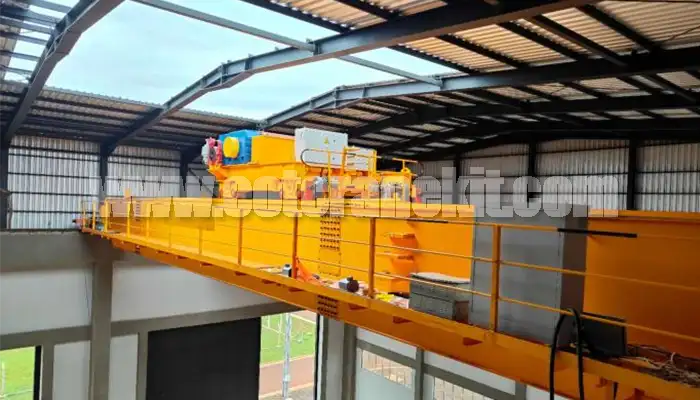
Latest project
150 Ton Overhead Crane Installation Feedback – Paraguay Case
QDX 150 ton overhead crane in action in Paraguay. Installation photos, video, and client feedback show performance, safety, and heavy-lifting efficiency.
Free consultation to Confirm Parameters & Specifications and Get
Latest Crane Price & Crane Rate.
- Types of overhead cranes : _______?
- Optional: Overhead travelling crane, goliath gantry crane,Slewing jib crane, Single girder or double girder crane,small portable crane or kbk crane, etc.
- Capacity of overhead crane: _______?
- Optional: 0.25ton, 0.5 ton, 1 ton, 2 ton, 3ton, 5 ton, 10 ton,15ton, 20ton, 25 ton, 30ton,35ton, up to 550ton, etc.
- Crane span & lifting height : _______?
- Crane travelling length : _____?
- Control of overhead crane:_______?
- Optional: pendant/ remote/cabin control
- Voltage supply of overhead crane:_____?
- Eg,: 380V50/60HZ,3Phase or others,etc.
- Application/usage of crane:_______?
- Eg,: Steel mill, ,injection mold, cement,stone, concrete,granite, general manufacturing, etc.
Just leave a message via the contact form and our hoist and crane engineer will contact you with in 24working hours.
Get In Touch
